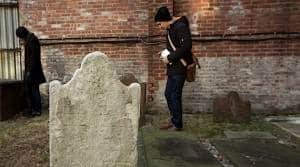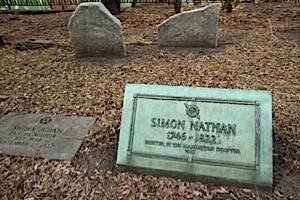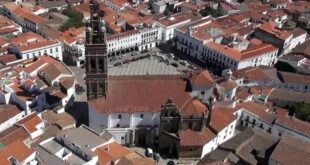By Josh Nathan-Kazis
Part 13: Chatham Square

I met up with my girlfriend in Casablanca two days later. (We went to Fez. I asked her to marry me. She said yes!) When we returned to Madrid the following Saturday for a stopover on the way home to New York, the garbage strike was over but the city seemed even more unsettled. We watched a tremendous protest moving up Calle Atocha from the window of our hostel, followed by a heavy retinue of riot police vans.
When we flew home to New York the next day, I was ready to leave.
I had arrived in Madrid to claim my birthright. I left unsure that it was mine.
It was, in part, realizing that Abraham de Lucena may not have actually been my ancestor, and that Luis Gomez may have actually been from Portugal, and that all these Iberians together only accounted for a minuscule trickle of my blood. And that, as a result, Gomez in Toledo and de la Obra in Córdoba, and even the tourism bureaucrats in Lucena, had a claim to the Spanish Jewish past that seemed even stronger than my own.
For the government, symbolic and apparently fake gestures towards the Sephardim seemed to be a diplomatic tactic. For the converts and the Spaniards claiming Jewish descent, identifying with the Sephardim looked, in some cases, like a bold resuscitation of an alternative Spanish identity that had been denied for generations. Viewed from another angle, it turned trendy and kitschy and a little anti-Semitic.
It repelled me. I didn’t really want to be Spanish anymore.
In fact, it didn’t seem like it would be an option. In early December, Spain’s right-wing ruling party introduced a measure in the parliament that reiterated the government’s interest in offering citizenship to Sephardic Jews but offered no further details on the plan. I emailed Royo to ask about the parliamentary group’s action; she sounded just as annoyed and bewildered as when we had met at her office.
“Business as usual: Waiting for them to announce the terms and requirements that the applicants for Spanish nationality will need,” she wrote.
Albacete did not respond to two emails, sent as this article approached publication, asking for updates on the passport law.
Portugal passed a law over the summer that made similar promises. Though the Portuguese law, unlike the Spanish law, is on the books, it’s just a single sentence offering citizenship to the descendants of Portuguese Sephardic Jews. A spokesman for the Portuguese embassy in the United States told me over email in early January that, contrary to press reports, the justice ministry was still writing a law that would establish specific requirements. So, right now, the Portuguese passports don’t exist either.
On Christmas Eve, I caught the end of the Spanish king’s annual address to the nation. He looked sad and tired. The next week, I organized an expedition to find Luis Gomez’s grave. Our group met at 9 a.m. on December 31 in Manhattan’s Chinatown. A statue of Confucius in Chatham Square faces north up the Bowery; we met behind his back, in front of the old Shearith Israel cemetery. It’s a tiny lot the size of a dog run. Zachary Edinger, Shearith Israel’s sexton, rode the subway downtown to unlock the iron gate for my cousin Jonathan, my brother Saul, Saul’s girlfriend Kristen, and me.
We had been inside a few times before, though not in years. No one has been buried at Chatham Square since the 1820s, but it’s the oldest Jewish cemetery in the United States, and the synagogue still holds ceremonies and memorials there. From the outside it doesn’t look like anything. I realized, as I waited for Edinger to open the gate, that I had walked by a thousand times since my last visit, each time forgetting it was there.
De Sola Pool’s book reports the English, Hebrew and Portuguese (Portuguese! Claim totally undermined) text of Gomez’s tombstone, but not its location. He died in 1740, after the purchase of the grounds, and likely would have been buried here. But the borders of the cemetery have been cut back over the years, and graves were lost. Gomez doesn’t appear on the map of the cemetery in the de Sola Pool book. We decided to look around.

It was freezing. The lock on the gate stuck when Edinger tried to get it open. He warmed it with his hands and tugged again; it snapped clear. Inside, the frozen ground cracked under our shoes as we treaded over the plots.
We saw the grave of Simon Nathan, our great-great-great-great-great-grandfather, who came from England in 1746. His brother-in-law, Gershom Mendes Seixas, the first rabbi born in North America, has a funny-looking pyramid-shaped grave right next to him. We saw the grave of Luis Gomez’s son Mordecai, another ancestor. But though we read every stone we could, Gomez himself didn’t seem to be there.
I didn’t feel defeated. Was Luis Gomez lost? I didn’t care. The long-dead ancestors, their bodies disintegrated, amount to a meaningless little genetic sliver in our source code. The men and women themselves were morally skewed — slave owners, if not slave traders. It wasn’t with them that I felt a connection.
The graves, however, represent something else. We’ve chosen to care about them. Our parents and grandparents had chosen to bring us here as kids so the bits of rock would stir us when we visited later. My grandfather and his father chose to lead the institution that kept the graves up. They’re ours not because of blood, but because we’ve made them ours.
We didn’t stay at Chatham Square long. Our feet were cold. It felt like it would snow soon. We hustled through Chinatown to a diner for breakfast.
Josh Nathan-Kazis is a staff writer at the Forward. Contact him at nathankazis@forward.com and on Twitter @joshnathankazis.
- Part 1 – 07/Feb/2014
- Part 2 – 08/Feb/2014
- Part 3 – 09/Feb/2014
- Part 4 – 10/Feb/2014
- Part 5 – 11/Feb/2014
- Part 6 – 12/Feb/2014
- Part 7 – 13/Feb/2014
- Part 8 – 14/Feb/2014
- Part 9 – 15/Feb/2014
- Part 10 – 16/Feb/2014
- Part 11 – 17/Feb/2014
- Part 12 – 18/Feb/2014
Fuente: http://m.forward.com
 eSefarad Noticias del Mundo Sefaradi
eSefarad Noticias del Mundo Sefaradi

